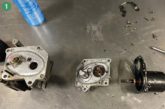2017 may well go down as a year to remember in terms world events. But aside from a certain blonde- haired President’s hapless attempts at leading the free world, and Britain’s messy exit from the European Union, the aftermarket has been through a tumultuous year of its own. In this article, Neil Pattemore provides his ‘end of term’ report for the aftermarket.
The trials and tribulations of diesel
One of the year’s biggest issues was the ‘Dieselgate’ fallout – a decline in new car sales and city taxes, but rising second hand diesel vehicle sales volumes. But, in my humble opinion, there is too much misguided hysteria surrounding diesels. Indeed, if you look at the complete picture – correctly serviced diesel vehicles with their respective DPFs and AdBlue systems – there is still a place for diesel systems in modern powertrains.
Electric and hybrid surge
The UK Government’s announcement that internal combustion engines will cease to be sold from 2040 has already started an increase in hybrid and electric vehicle sales. Whilst the announcement brings new opportunities, it also leads to competency issues, making training and equipment the order of the day.
Data accessibility
In Brussels, the existing vehicle type approval framework legislation is currently being reviewed, including the rights for independent workshops to access vehicle repair and maintenance information. Fortunately, the European aftermarket associations have worked hard to ensure that the critical elements of the 2014 Ricardo AEA report are included.
There were a significant number of non-compliances reported, with recommendations on how the legislation should be updated. These type approval revisions have now reached a critical stage of discussion known as ‘trilogue’, meaning we will know early next year if the in-vehicle data can still be accessed through the OBD port.
Another important element to be included in the type approval revisions is the SERMI (Security Repair and Maintenance Information). When the SERMI scheme is implemented, independent workshops will have access to a vehicle manufacturer’s website for vehicle ‘security’ repair information. An authorised technician connects the vehicle to the internet using a standardised vehicle communication interface (VCI), a Windows-based PC and, subsequently, the appropriate VM website. When security information is requested, the VM website will check the validity of the SERMI certificate and the associated technician’s PIN with the Trust Centre. If they are validated, the connection is confirmed and the data is made available to the workshop.
The 4-1-1
Earlier this year, the proposal to review the frequency of MOTs reared its ugly head again. Previously, EU Commissioner for Transport, Violeta Bulc, said: “We have achieved impressive results in reducing road fatalities over the last decades, but the current stagnation is alarming.” After many years of
steady decline, road fatalities have started to rise in the UK. It therefore seems inconceivable that the UK government can justify extending the first MOT test to four years, when their own research conducted by the Transport Research Laboratory (TRL) concluded: “Reducing the frequency of testing for newer vehicles is likely to have adverse road safety consequences”.
Automated systems
Since 2014 there has been the mandatory introduction of ‘driver aids’, or more correctly ‘advanced driver assistance systems’ (ADAS), which encompasses stability control, lane departure warnings and emergency braking systems. All of these systems are designed to reduce accidents. This is the new world of automated cars, not to be confused with the new world of autonomous cars – where the car is designed to operate without any driver input at all. However, the requirement to calibrate the ADAS cameras and sensors creates a new opportunity for the workshop. The increased number of automated systems will require recalibration after an accident, windscreen replacement or system repair.
This requires specialist equipment and access to the appropriate diagnostic software. Whilst this might be an opportunity for the independent workshop, it could also introduce the requirement to prove your ability to work on these systems, in order to ensure the continued operational safety of the vehicle.
Connected cars
Another substantial development this year is the vehicle manufacturers’ increasing ability to remotely access vehicles, consequently entering the aftermarket as a provider of diagnostic, repair and maintenance services. This allows them to directly communicate with the driver, propose a repair or service offer, direct them to a workshop proposed by the vehicle manufacturer and then to use the vehicle manufacturer’s spare parts within their offer.
An unprecedented threat?
The fundamentals of the aftermarket – free of charge, unmonitored access to in-vehicle data and the ability to offer customers a competitive choice – are under serious threat. This arises not only from the ability to access vehicle data, and subsequently for the aftermarket to maintain independent repair methods, but now to evolve to offer new ‘remote services’.
Behind all of this lies the basis of future business models: controlling access to the vehicle, its data and resources. So another important happening this year was the release of a TRL study, which considered how this may be possible in the future. This report has yet to be discussed in Brussels, but includes the following key aspects:
- All options are both legally and technically feasible (the aftermarket proposes an on-board application platform)
- Real-time and direct access not possible using a data server option (the vehicle manufacturers’ proposal)
- Equal access to HMI (dashboard display) – displaying services to the driver is only possible with the on-board application platform
- Although a data server could be implemented quickly (between one and two years), the on-board application platform will take longer (five or more years)
However, there were some further key points that more directly support the aftermarket:
- The potential benefits from direct access to in-vehicle data outweigh the costs of any model needed to access the data
- Legislation is recommended to achieve the on-board application platform
The need for legislation
Looking back at this year and forward to next year – it has been and will remain a disruptive situation, whereby, in order to make any meaningful progress and avoid the ‘playground bullies’, some stricter rules from the legislator are needed!











